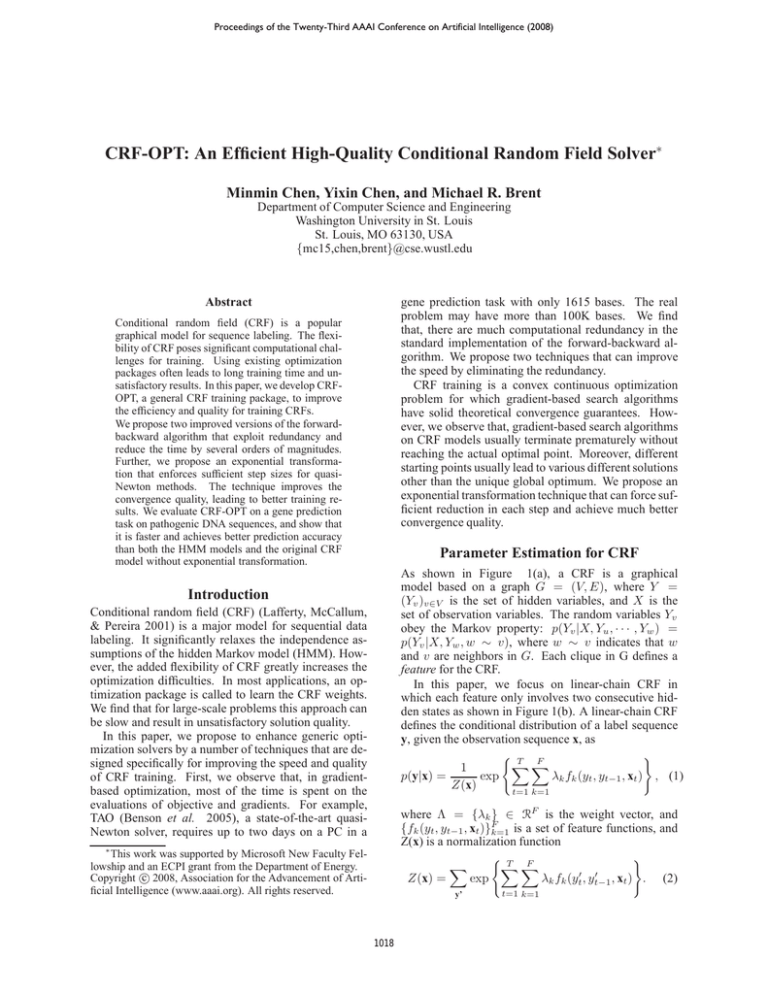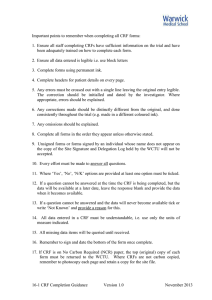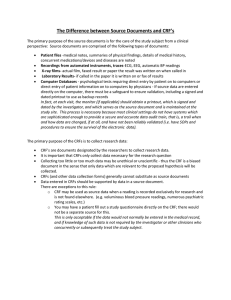
Proceedings of the Twenty-Third AAAI Conference on Artificial Intelligence (2008)
CRF-OPT: An Efficient High-Quality Conditional Random Field Solver∗
Minmin Chen, Yixin Chen, and Michael R. Brent
Department of Computer Science and Engineering
Washington University in St. Louis
St. Louis, MO 63130, USA
{mc15,chen,brent}@cse.wustl.edu
gene prediction task with only 1615 bases. The real
problem may have more than 100K bases. We find
that, there are much computational redundancy in the
standard implementation of the forward-backward algorithm. We propose two techniques that can improve
the speed by eliminating the redundancy.
CRF training is a convex continuous optimization
problem for which gradient-based search algorithms
have solid theoretical convergence guarantees. However, we observe that, gradient-based search algorithms
on CRF models usually terminate prematurely without
reaching the actual optimal point. Moreover, different
starting points usually lead to various different solutions
other than the unique global optimum. We propose an
exponential transformation technique that can force sufficient reduction in each step and achieve much better
convergence quality.
Abstract
Conditional random field (CRF) is a popular
graphical model for sequence labeling. The flexibility of CRF poses significant computational challenges for training. Using existing optimization
packages often leads to long training time and unsatisfactory results. In this paper, we develop CRFOPT, a general CRF training package, to improve
the efficiency and quality for training CRFs.
We propose two improved versions of the forwardbackward algorithm that exploit redundancy and
reduce the time by several orders of magnitudes.
Further, we propose an exponential transformation that enforces sufficient step sizes for quasiNewton methods. The technique improves the
convergence quality, leading to better training results. We evaluate CRF-OPT on a gene prediction
task on pathogenic DNA sequences, and show that
it is faster and achieves better prediction accuracy
than both the HMM models and the original CRF
model without exponential transformation.
Parameter Estimation for CRF
As shown in Figure 1(a), a CRF is a graphical
model based on a graph G = (V, E), where Y =
(Yv )v∈V is the set of hidden variables, and X is the
set of observation variables. The random variables Yv
obey the Markov property: p(Yv |X, Yu , · · · , Yw ) =
p(Yv |X, Yw , w ∼ v), where w ∼ v indicates that w
and v are neighbors in G. Each clique in G defines a
feature for the CRF.
In this paper, we focus on linear-chain CRF in
which each feature only involves two consecutive hidden states as shown in Figure 1(b). A linear-chain CRF
defines the conditional distribution of a label sequence
y, given the observation sequence x, as
( T F
)
XX
1
p(y|x) =
exp
λk fk (yt , yt−1 , xt ) , (1)
Z(x)
t=1
Introduction
Conditional random field (CRF) (Lafferty, McCallum,
& Pereira 2001) is a major model for sequential data
labeling. It significantly relaxes the independence assumptions of the hidden Markov model (HMM). However, the added flexibility of CRF greatly increases the
optimization difficulties. In most applications, an optimization package is called to learn the CRF weights.
We find that for large-scale problems this approach can
be slow and result in unsatisfactory solution quality.
In this paper, we propose to enhance generic optimization solvers by a number of techniques that are designed specifically for improving the speed and quality
of CRF training. First, we observe that, in gradientbased optimization, most of the time is spent on the
evaluations of objective and gradients. For example,
TAO (Benson et al. 2005), a state-of-the-art quasiNewton solver, requires up to two days on a PC in a
k=1
where Λ = {λk } ∈ RF is the weight vector, and
{fk (yt , yt−1 , xt )}F
k=1 is a set of feature functions, and
Z(x) is a normalization function
( T F
)
X
XX
′
′
Z(x) =
exp
λk fk (yt , yt−1 , xt ) . (2)
∗
This work was supported by Microsoft New Faculty Fellowship and an ECPI grant from the Department of Energy.
c 2008, Association for the Advancement of ArtiCopyright ficial Intelligence (www.aaai.org). All rights reserved.
y’
1018
t=1 k=1
operation
time (sec)
exp
+
*
/
FE
8.093
0.203
0.203
0.203
0.448
Table 1: Timing results for 108 runs of some operations and
a 7-th order feature evaluation (FE) on a PC with Xeon 2.4
GHz CPU and 2GB memory running Linux.
In practice, to make the code numerically stable, the
forward variables αt are processed in logarithmic forms
by taking logarithms for both sides of equation (4) :
Figure 1: (a) A general CRF model. (b) A linear-chain
CRF model.
log(αt (s)) = log(αt−1 (s0 )) + Φt (s0 , s, xt )
„
„
X
+ log 1 +
exp log(αt−1 (s′ )) + Φt (s′ , s, xt )
The predefined feature fk (yc , xc ) typically returns a
binary value. For example, a feature can be defined as:
s′ 6=s0
fk (yc , xc ) = 1{yt−1 =N C} 1{yt =C} 1{xt···t+2 =′ AT G′ }
− log(αt−1 (s0 )) − Φt (s0 , s, xt )
It is 1 when the hidden state yt−1 is NC, yt is C, and the
observations at time t to t + 2are ’ATG’. N
Given training data D = (x(i) , y(i) ) i=1 , to estimate the weights {λk }, we typically maximize a penalized conditional log likelihood:
maximizeΛ O(Λ) =
N
X
log p(y(i) |x(i) ) −
i=1
F
X
λ2k
. (3)
2δ 2
k=1
2
The second term is a zero-mean, δ -variance gaussian
prior to penalize large weight norm (McCallum 2003).
It is a convex optimization problem with only one
global optimum. Generally, the objective function cannot be maximized in closed form and numerical optimization is used.
Efficient Function Evaluations
We have developed CRF-OPT, a package for general
CRF training, on top of the Limited Memory Variable
Metric (LMVM) solver in the Toolkit for Advanced
Optimization (TAO) (Benson et al. 2005). LMVM
is a quasi-Newton method that requires only function
and gradient information, which are evaluated by the
forward-backward algorithm.
The forward-backward algorithm
We briefly review the standard forward-backward algorithm which is a core routine for CRF training. Without loss of generality, we assume that there is only one
(N = 1) training sequence.
We discuss the forward process as the backward process is symmetric. Let S be the set of all possible states,
and start be an arbitrary fixed starting state. For each
index t ∈ 1, 2, · · · , T , and label s ∈ S, the forward
variables αt (s) can be defined recursively as:
X
αt (s) =
αt−1 (s′ ) exp(Φt (s′ , s, xt )),
(4)
««
(5)
where s0 ∈ S can be any state. We set s0 to be the
state with the maximum log(αt−1 (s)) to further improve the numerical stability when calculating the exponential part.
We analyze the complexity of various operations
used by forward-backward. Let T be the length of the
training sequence, F the total number of features, M
the number of possible states (M = |S|), and I be
the number of iterations taken by the optimization algorithm to converge.
Most existing CRF packages, such as MALLET (McCallum 2002), MinorThird (Cohen 2004), Sarawagi’s
package (Sarawagi et al. 2004), and Murphy’s package (Murphy & Schmidt 2006), iterate through all
features to find the set of indices of active features Kt (s′ , s) for each step t, and each transition
(s′ , s). Therefore, a full forward computation requires
Θ(T F M 2 ) feature evaluations. Each iteration of a
gradient-based optimization algorithm requires an objective and gradient evaluation, resulting in a total of
Θ(T F M 2 I) feature evaluations. Each time we compute log(αt (s)) using (5), we need to perform Θ(M )
exponentiations. Therefore, the optimization requires
in total Θ(T M 2 I) exponentiations.
We examine the complexity of each basic operation.
The results are shown in Table 1. We see that in our
platform, exp is 40 times more expensive than simple
operations. This motivates us to reduce the number of
exponentiations in the following two implementations
of forward-backward.
Feature-vector fast forward (FVFF)
We propose a feature-vector fast forward (FVFF)
method shown in Algorithm 1. It implements the
forward process to compute αt (s). In this method,
Kt (s, s′ ) is the set of active features: Kt (s, s′ ) =
{k|fk (s′ , s, xt ) = 1, k = 1, · · · , F }. Φt (s′ , s, xt ) is
the sum of weights of all active features
at step t, with
P
transition (s′ , s): Φt (s′ , s, xt ) = k∈Kt (s′ ,s) λk .
Since the active feature set Kt (s, s′ ) remains identical in each iteration of the optimizer, a preprocessing
phase (Line 2) is used in Algorithm 1 to construct and
store Kt (s, s′ ) for all the t, s′ and s.
s′ ∈S
P
where Φt (s′ , s, xt ) =
k∈Kt (s′ ,s) λk , α0 is 1
for start and 0 for other states, and Kt (s′ , s) =
{k | fk (s′ , s, xt ) = 1, k = 1 · · · F } is the set of active
features for a given transition at time t.
1019
standard
FVFF
OSFF
preprocessing
time
Θ(1)
Θ(T F M 2 )
Θ(T G + JF M 2 )
preprocessing
space
Θ(1)
Θ(T V M 2 )
Θ(T P + JV M 2 )
running
space
Θ(T M )
Θ(T V M 2 + F )
Θ(T M + JV M 2 )
feature
evaluations
Θ(T F M 2 I)
Θ(1)
Θ(1)
number of
exponentiations
Θ(T M 2 I)
Θ(Fa I)
Θ(JM 2 I)
Table 2: Comparison of the standard implementation of forward-backward and the two proposed schemes, assuming each feature
evaluation takes Θ(1) time.
time steps t. Certain observation patterns repeatedly occur in the observation sequence, which motivate a new
observation-substring fast forward (OSFF) algorithm.
For each feature fk (s′ , s, xt ), we first find out the observation pattern p. For example, the observation pattern p1 for feature f1 (s′ , s, xt−1 = a, xt = b, xt+1 = c)
is (ab, c), where the comma here indicates the position of t. The pattern for f3 (s′ , s, xt−2 = a, xt−1 =
a, xt+1 = c) is (aa∗, c), where ∗ means this position is
not defined. Let P be the set of all observation patterns.
The forward computation is performed once in each
iteration of the optimizer. For those features included
in at least one of the active feature sets, the exponential
weight Ek is precomputed and stored to avoid future exponential operations (Line 4). As in Line 6, C(t, s′ , s)
is computed using the production of Ek . The logarithm of each forward variable log(αt (s)) is stored in
A(t, s), ∀t = 1, . . . , T, s ∈ S.
Proposition 1. The FVFF algorithm correctly computes the forward variables and we have
A(t, s) = log(αt (s)), ∀t = 1, · · · , T, s ∈ S.
Algorithm 1: feature vector fast forward (FVFF)
1 A. preprocessing phase (executed once)
2
compute Kt (s′ , s),∀ t = 1..T , s, s′ ∈ S;
3 B. forward computation (for each iteration)
4
compute Ek = exp(λk ) if k ∈ any Kt (s′ , s);
5
foreach state s ∈ S do
6
set A(1, s) = Φ1 (start,
Q s, x1 ), L(1, s) = 1,
C(1, start, s) = k∈K1 (start,s) Ek ;
7
end do;
8
set s′0 = start;
9
for t = 2 to T do
10
find s0 ∈ S that maximizes A(t − 1, s0 );
11
foreach state s ∈ S do
Q
12
set C(t, s0 , s) = k∈Kt (s0 ,s) Ek ;
13
end do;
14
foreach state s ∈ S do
15
/* using precomputed Kt (s′ , s) */
set B(t, s) = A(t − 1, s0 ) + Φt (s0 , s, xt );
16
set L(t, s) = 1;
17
foreach state s′ ∈ S, Q
s′ 6= s0 do
18
set C(t, s′ , s) = k∈Kt (s′ ,s) Ek ;
19
set L(t, s) = L(t, s)+
L(t−1,s′ )C(t−1,s′0 ,s′ )C(t,s′ ,s)
;
L(t−1,s0 )C(t−1,s′0 ,s0 )C(t,s0 ,s)
20
end do;
21
set A(t, s) = B(t, s) + log(L(t, s));
22
end do;
23
set s′0 = s0 ;
24
end do;
We omit the full proof but give some key equations here. The key for reducing exponential operations
is to compute C(t, s′ , s), which is the exponential of
Φt (s′ , s, xt ), using precomputed Ek :
Y
′
′
C(t, s , s) = exp Φt (s , s, xt ) =
Ek
k∈Kt (s′ ,s)
B(t, s) corresponds to the first part of (5):
B(t, s) = log(αt−1 (s0 )) + Φt (s0 , s, xt )
L(t, s) stores the term within the second log of (5):
X
L(t, s) =
exp log(αt−1 (s′ )) + Φt (s′ , s, xt )
s′ 6=s0
− log(αt−1 (s0 )) − Φt (s0 , s, xt ) + 1
Let V be the maximum number of active features for
any given transition (s′ , s) and t. Typically V is very
small comparing to F or T . The complexity of FVFF
is shown in the second line of Table 2. Comparing
to the cost of the standard implementation of forwardbackward algorithm, we see several differences. First,
in the preprocessing phase, FVFF takes Θ(T F M 2)
time and Θ(T V M 2 ) space to figure out and store the
Kt (s′ , s) sets. Second, in FVFF, the exp operation only
takes place in the calculation of the Ek values for those
features appear in one of the Kt (s′ , s) sets, in each iteration of the optimizer. Let Fa be the total number of active features. There are at most Θ(Fa I) exp operations
in contrast to Θ(T M 2 I) for standard implementation.
In most applications, we have Fa ≪ F ≪ T M 2 .
If a pattern p2 must be satisfied when pattern p1 is
satisfied, we say that p1 implies p2. For example, (a, bc)
implies (a, b). We construct a pattern implication forest
Fp as shown in Figure 4. Each node in Fp represents
a pattern in P , and is distributed in different layers of
Fp according to the number of defined positions in the
pattern. There is an edge p1 → p2 if p1 implies p2 .
We then collect the active pattern set Ω, a subset of
P , by mapping each step t of the training sequence
into patterns. For each t ∈ 1, 2, · · · , T , we search Fp
in a top-down fashion to find those highest-level patterns matching the observations at t. For example, if
Observation-substring fast forward (OSFF)
Through experimentation, we have found that a great
number of Kt (s′ , s) sets remain the same for different
1020
lem parameters vary by applications, there are some
typical observations. First, T , the sequence length, is
always orders of magnitude larger than F and M .
For example, in a gene prediction CRF, T can be
as large as 300K to millions. Second, F tends to be
smaller than T but greater than M . For example, in
gene prediction, there are typically M =7 to 50 states.
We have F = M × 4n+1 + M 2 , where n is the order of
features whose typical value ranges from 1 to 7.
For a given problem with fixed T , F , M and other
parameters, we can also estimate which of FVFF and
OSFF has a lower complexity. As a general guideline,
FVFF is better than OSFF when F is smaller than JM 2 ,
while OSFF is more favorable when JM 2 is smaller
than F or when J is much smaller than T .
Figure 2: A pattern implication forest illustrating the
implication relations between observation patterns.
the observations at t is (AT,G), then (AT,G) is selected
but (AT,) is not. The patterns are added to Ω, and the
mapping of step t is saved in π(t), the set of indices of
matched patterns in Ω. Let J = |Ω|.
For each of the pattern ωj , we define the pattern implication set Kjω , j = 1..J as:
Algorithm 2: observation substring fast forward
1 A. preprocessing phase (executed once)
2
create the Ω set and the mapping π(t);
3
compute the set Kjω (s′ , s),∀ j = 1..J, s, s′ ∈ S;
4 B. forward computation (for each iteration)
5
for j = 1 to J, ∀s′ , s ∈ S do
P
6
set C ω (j, s′ , s) = exp( k∈K ω (s′ ,s) λk );
j
7
end do;
8
foreach state s ∈ S do
9
set A(1, s) = Φ1 (start,
Q s, x1 ), L(1, s) = 1,
C(1, start, s) = j∈π(1) C ω (j, start, s);
10
end do;
11
set s′0 = start;
12
for t = 2 to T do
13
find s0 ∈ S that maximizes
A(t − 1, s0 ) ;
Q
14
C(t − 1, s′0 , s0 ) = j∈π(t−1) C ω (j, s′0 , s0 )
15
foreach state s ∈ S do
16
B(t, s) = A(t − Q
1, s0 ) + Φt (s0 , s, xt );
17
set C(t, s0 , s) = j∈π(t) C ω (j, s0 , s);
18
set L(t, s) = 1;
19
foreach state s′ ∈ S, s′ 6= s0 do
′
′
20
C(t −
Q1, s0 , s ) =ω
C (j, s′0 , s′ );
j∈π(t−1)
Q
′
21
C(t, s , s) = j∈π(t) C ω (j, s′ , s);
22
L(t, s) = L(t, s)+
L(t−1,s′ )C(t−1,s′0 ,s′ )C(t,s′ ,s)
;
L(t−1,s0 )C(t−1,s′0 ,s0 )C(t,s0 ,s)
23
end do;
24
set A(t, s) = B(t, s) + log(L(t, s));
25
end do;
26
set s′0 = s0 ;
27
end do;
Kjω = {m|pm ∈ P, pm is implied by ωj }
The set can be easily constructed by collecting all the
descendants of pattern ωj in Fp .
Further, we define the pattern-transition set
Kjω (s′ , s), ∀s′ , s ∈ S, j = 1..J as:
Kjω (s′ , s) = {k|fk (s′ , s, pm ) is a feature , m ∈ Kjω )}
where pm is a pattern in the pattern implication forest.
Normally, there are lots of implication relationships
between the observation patterns appeared in the features and we have J ≪ F .
The OSFF algorithm is shown in Algorithm 2. In
the preprocessing phase, it creates the Ω and Kjω (s′ , s)
sets. The forward computation differs from FVFF in
that, instead of computing C(t, s′ , s) for each t, OSFF
computes and stores C ω (j, s′ , s), the exponential of the
total weight for each Kjω (s′ , s) set.
Proposition 2. The OSFF correctly computes the forward variables and we have A(t, s) = log(αt (s)), ∀
t = 1, · · · , T, s ∈ S.
The correctness of OSFF can be shown in a similar way as FVFF. The main difference is that, instead
of precomputing C(t, s′ , s) at the beginning of each iteration, OSFF precomputes C ω (j, s′ , s) (Line 6) and
comes up with C(t, s′ , s) from C ω (j, s′ , s) using the
mapping π(t) (Line 14).
Let G be the total number of nodes in the forest, and
P is the maximum number of active pattern for each
position t. Typically, G and P are much smaller than
F . The last line of Table 2 shows the time complexity
of OSFF. For the preprocessing time, OSFF is more efficient than FVFF when J ≪ T . In terms of the exponentiations, the OSFF is more efficient when JM 2 ≤ F .
Table 3 validates the complexity saving. As shown in
Table 3, for a problem with a large number of features,
even for a short sequence with only 1615 symbols, the
time for solving it using the standard forward-backward
algorithm is prohibitive.
Both FVFF and OSFF use A(t, s) = B(t) +
log(L(t, s)) to compute the logarithmic form of αt (s).
By leaving B(t) = A(t − 1, s0 ) + Φt (s0 , s, xt ) out of
the log, the algorithms are as numerically stable as the
standard implementation.
Discussions and validation
As listed in Table 2, both FVFF and OSFF are much
faster than the original algorithm. Although the prob-
1021
standard
FVFF
OSFF
M = 7, F = 28721, J = 4096
T = 1615
T = 266225
≈ 48hours
84 seconds
≈ 4hours
282 seconds
≈ 2.5hours
Table 3: The training time of different algorithms on a
PC with 2.4GHz CPU.
Exponential Transformation
We address another issue regarding the optimization
quality. We have found that the quasi-Newton method
often terminates prematurely when optimizing a CRF.
We illustrate the observation by an example. The model
we use is a toy casino gambling model, where there is a
fair die with even probability (1/6) for rolling each number, and a loaded die with a higher probability (1/2) for
rolling a six. There are two possible underlying states,
fair or loaded, with different emission probabilities. Using a total of 16 features, the task is to infer which die
is used given a sequence of numbers.
In our experiment, we found that, different starting
points lead to different, non-optimal solutions. To visualize the search, in Figure 3, we plot two variables, with
each axis corresponding to one variable. For these two
variables, the optimal values are located at [0, 0]. We
can see that, when the optimization terminates, the solutions from different starting points, marked by black
circles in Figure 3a, are very different and far from the
optimal point. We find that, the search often terminates
when the difference of the objective between two consecutive iterations is smaller than a threshold 1.0e-04.
Experimental results show that reducing the threshold
will only cause negligibly small numerical differences.
To address this issue, we add a second round of optimization after LMVM terminates. In this round, we apply an exponential transformation to the original objective function formulation and optimize the transformed
objective. Let Λ0 be the solution of LMVM and let its
function value be O0 = O(Λ0 ), where the CRF objective function O(Λ) is defined in (3). In the transformation, we use the following new objective:
χ(Λ) = exp (O(Λ) − O0 )
a) Original LMVM from various starting points.
b) LMVM with exponential transformation.
Figure 3: Search trajectories before and after using the
exponential transformation.
the improvements along the search trajectory and allows
the optimizer to converge closely to an optimal point
without early termination. This effect is illustrated in
Figure 3b, where the termination points after using the
exponential transformation are marked by triangles. We
can clearly see that the exponential transformation can
enforce the search to converge very closely to the same
optimal solution, regardless of the starting point.
(6)
Experimental Results
It is obvious that the optimal Λ maximizing O(Λ)
also maximizes χ(Λ), thus guaranteeing the correctness
of our approach. The complexity for computing χ(Λ)
is low since in each search iteration, it only requires one
more exponentiation after O(Λ) is obtained. The gradient of χ(Λ) is, ∀k = 1, · · · , F ,
∂O(Λ)
∂χ(Λ)
= exp (O(Λ) − O0 )
.
∂λk
∂λk
We have developed a software package, named CRFOPT, that integrates the fast forward algorithms and exponential transformation into the TAO package.
We present results on a gene prediction task.
Given a DNA observation sequence, consisting of
’A’,’T’,’G’,’C’ bases, the aim of gene prediction is to
find out the protein coding regions, known as genes,
and their associated components, including coding exons, start/stop exons, promoters, and poly-adenylation
sites (Burge. 1997).
Figure 4 shows a finite state machine representation
of the structure of genomic sequences in our implementation. In this model, each circle represents a hidden
state, such as exon (C), intron (I), and intergenic re-
(7)
Therefore, there is little additional overhead for computing the gradients.
We can see from (7) that, for any new point with a
higher objective value than that of Λ0 , we have ∂χ(Λ)
∂λk >
∂O(Λ)
∂λk .
Thus, the exponential transformation magnifies
1022
Table 4: The performance of HMM and CRF on the gene prediction data sets.
Measure
Gene Sensitivity(%)
Gene Specificity(%)
Transcript Sensitivity(%)
Transcript Specificity(%)
Exon Sensitivity(%)
Exon Specificity(%)
Nucleotide Sensitivity(%)
Nucleotide Specificity(%)
HMM
2.50
1.89
2.50
1.89
15.42
16.43
81.70
89.33
Set 1
CRF
7.50
6.82
7.50
6.82
37.00
43.30
90.35
88.54
eCRF
7.50
7.14
7.50
7.14
35.68
41.33
89.96
87.89
HMM
0
0
0
0
35.44
32.56
78.26
92.33
Set 2
CRF
2.50
2.13
2.50
2.13
25.32
30.00
84.21
89.64
eCRF
5.00
5.88
5.00
5.88
34.18
40.30
90.13
90.91
HMM
2.17
2.00
2.17
2.00
36.63
34.36
86.06
92.02
Set 3
CRF
4.35
4.35
4.35
4.35
34.43
39.66
90.62
89.54
eCRF
4.35
4.44
4.35
4.44
34.43
39.83
90.79
90.45
HMM
4.08
4.00
4.08
4.00
31.72
32.39
82.66
94.19
Set 4
CRF
2.04
1.79
2.04
1.79
28.62
33.88
92.84
90.67
eCRF
4.08
4.00
4.08
4.00
32.41
37.01
93.45
92.38
the results of the standard implementation of forwardbackward because it will take more than a month to finish on our workstation with Intel Xeon 2.4 GHz CPU
and 2GB memory running Linux.
The gene prediction model used in our experiment is
still a much simplified one. Yet, the results show the
effectiveness of the proposed work. As shown in the
result, CRF-OPT gives better performance than HMM
using the same feature set. Moreover, our proposed
exponential transformation further improves the prediction accuracy, especially for the higher-level gene,
transcript, and exon level measures. The improvement
shows that it is beneficial to achieve high-precision convergence to the global optimal solution using exponential transformation.
Figure 4: A finite state machine for gene prediction
gion (N C). In our model, the introns and exons are
further divided into three phases according to the reading frame. Each edge represents a possible hidden state
transition with required base observation.
The features used in our model are the state transition
and base observation requirement as represented by the
edges in Figure 4 and a 5th order bases emission information. In total we have around 7 · 46 features.
We test our algorithm on a DNA sequence with 570K
bases. The performance is evaluated at four different levels (Burge. 1997). A higher level accuracy is
typically more difficult to achieve as it requires more
consecutive correct predictions at the nucleotide level.
For each level, we use the standard sensitivity (Sn) and
P
specificity (Sp) measures defined as Sn = T PT+F
N and
TP
Sp = T P +F P , where TP, FN, FP denote the numbers
of true positive, false negative, and false positive labels,
respectively (Burge. 1997).
We compare the performance of the CRF model before and after using the exponential transformation.
Also, since our CRF model uses 5th order features, we
compare the results to the corresponding 5th order Hidden Markov Model (HMM) implementation with the
same state transition model and splice sites information.
We estimate the accuracy of our predictor using
Holdout Validation and show the results in Table 4.
There are 170 genes in the data set. We use all these
genes to construct four different data sets. We randomly split the data into 75% training data and 25%
testing data. For each test set, we show the performance of HMM and CRF. For each set, CRF denotes the original CRF without exponential transformation and eCRF denotes the CRF using exponential
transformation. Both use the OSFF implementation
of the forward-backward algorithm. We do not show
References
Benson, S. J.; McInnes, L. C.; Moré, J.; and Sarich, J.
2005. TAO user manual (revision 1.8). Technical Report
ANL/MCS-TM-242, Mathematics and Computer Science
Division, Argonne National Laboratory.
Burge., C. 1997. Identification of genes in human genomic
DNA. Ph.D. Dissertation, Stanford Univerisity.
Cohen, W. W.
2004.
Minorthird: Methods for
identifying names and ontological relations in text
using heuristics for inducing regularities from data.
http://minorthird.sourceforge.net.
Gross, S. S.; Do, C. B.; Sirota, M.; and Batzoglou, S. 2007.
Contrast: a disriminative, phylogeny-free approach to multiple informant de novo gene prediction. Genome Biology
8:R269.
Lafferty, J.; McCallum, A.; and Pereira, F. 2001. Conditional
random fields: Probabilistic models for segmenting and labeling sequence data. International Conference on Machine
Learning.
McCallum, A. K. 2002. Mallet: A machine learning for
language toolkit. http://mallet.cs.umass.edu.
McCallum, A. 2003. Efficiently inducing features of conditional random fields. Conference on Uncertainty in Artificial
Intelligence.
Murphy, K., and Schmidt, M. 2006. Crf toolbox for matlab.
http://www.cs.ubc.ca/ murphyk/Software/CRF/crf.html.
Sarawagi, S.; Jaiswal, A.; Tawari, S.; Mansuri, I.; Mittal,
K.; and Tiwari, C. 2004. Sunita sarawagi’s crf package.
http://crf.sourceforge.net.
1023





